An Optimal Framework for WDM Systems Using Analytical Characterization of Refractive Index-Related Nonlinear Impairments
Abstract
1. Introduction
1.1. Related Work
1.2. Major Contributions
- Transmission distances of up to 500 km have been used in this work and the corresponding nonlinear effects have been investigated.
- The proposed system is analyzed through an analytical and simulation model. The characterization is presented through a mathematical model and an optimal design is proposed using frequency domain-multiple in multiple out (FD-MIMO) equalizer and microstrip chedyshev low pass filter.
- The parameters used for simulation analysis include channel spacing, nonlinear refractive index, fiber length, input power, and nonlinear dispersion, to ensure a comprehensive analysis.
- The performance of the proposed model is quantified in terms of BER and OSNR, where these two parameters are achieved below and above 25, respectively.
- FWM, XPM and SPM are reduced successfully till 500 km covered distance for channel spacing as low as 25 GHz and number of channels as much as 32.
2. Proposed Model Layout
Refractive Index Related Non-Linearities
3. Analytical Modeling
4. Results and Discussion
5. Conclusions
Author Contributions
Funding
Institutional Review Board Statement
Informed Consent Statement
Data Availability Statement
Acknowledgments
Conflicts of Interest
References
- Ali, F.; Khan, Y.; Muhammad, F.; Habib, U.; Abbas, Z.H.; Khan, M.A.; Ali, A. Extenuation of phase shift influenced nonlinear impairments in fiber optics network. Trans. Emerg. Telecommun. Technol. 2020, 31, e3930. [Google Scholar] [CrossRef]
- Muhammad, F.; Ali, F.; Habib, U.; Usman, M.; Khan, I.; Kim, S. Time domain equalization and digital back-propagation method-based receiver for fiber optic communication systems. Int. J. Opt. 2020, 2020, 3146374. [Google Scholar] [CrossRef]
- Ali, F.; Ahmad, S.; Muhammad, F.; Habib, U.; Kim, S. Adaptive equalization for dispersion mitigation in multi-channel optical communication network. Electronic 2019, 8, 1364. [Google Scholar] [CrossRef]
- Xu, T.; Shevchenko, N.A.; Semrau, D.; Liga, G.; Alvarado, A.; Killey, R.I.; Bayvel, P. Modulation format dependence of digital nonlinearity compensation performance in optical fibre communication systems. Opt. Express 2017, 25, 3311–3326. [Google Scholar] [CrossRef] [PubMed]
- Agrell, E.; Karlsson, M.; Chraplyvy, A.R.; Richardson, D.J.; Krummrich, P.M.; Winzer, P.; Roberts, K.; Fischer, J.K.; Savory, S.J.; Eggleton, B.J.; et al. Roadmap of optical communications. J. Opt. 2016, 18, 063002. [Google Scholar] [CrossRef]
- Cartledge, J.C.; Guiomar, F.P.; Kschischang, F.R.; Liga, G.; Yankov, M.P. Digital signal processing for fiber nonlinearities. Opt. Express 2017, 25, 1916–1936. [Google Scholar] [CrossRef] [PubMed]
- Bakhshali, A.; Chan, W.Y.; Cartledge, J.C.; Sullivan, M.O.; Laperle, C.; Borowiec, A.; Roberts, K. Frequency-domain Volterra-based equalization structures for efficient mitigation of intrachannel Kerr nonlinearities. J. Lightwave Technol. 2016, 34, 1770–1777. [Google Scholar] [CrossRef]
- Liu, X.; Chraplyvy, A.; Winzer, P.; Tkach, R.; Chandrasekhar, S. Phase-conjugated twin waves for communication beyond the Kerr nonlinearity limit. Nat. Photonics 2013, 7, 560. [Google Scholar] [CrossRef]
- Habib, U.; Aighobahi, A.E.; Nair, M.; Zhu, H.; Quinlan, T.; Walker, S.D.; Gomes, N.J. Performance improvement for OFDM-RoF transported 60 GHz system using spatial diversity and multiplexing. In Proceedings of the IEEE International Conference on Communications Workshops (ICC Workshops), Paris, France, 21–25 May 2017; pp. 211–216. [Google Scholar]
- Habib, U.; Steeg, M.; Stöhr, M.A.; Gomes, N.J. Radio-over-fiber-supported 60GHz multiuser transmission using leaky wave antenna. In Proceedings of the IEEE International Topical Meeting on Microwave Photonics (MWP), Beijing, China, 23–26 October 2017; pp. 1–4. [Google Scholar]
- Ali, F.; Muhammad, F.; Habib, U.; Khan, Y.; Usman, M. Modeling and minimization of FWM effects in DWDM-based long-haul optical communication systems. Photon Netw. Commun. 2020. [Google Scholar] [CrossRef]
- Kishikawa, H.; Uetai, M.; Gotoi, N. All-Optical Modulation Format Conversion between OOK, QPSK, and 8QAM. J. Lightwave Technol. 2019, 37, 3925–3931. [Google Scholar] [CrossRef]
- Liga, G.; Saavedra, G.; Bayvel, P. Combining Optical Phase Conjugation and Volterra Equalisation: A Novel Nonlinearity Compensation Scheme. J. Lightwave Technol. 2018, 36, 377–400. [Google Scholar]
- Rademacher, G.; Luis, R.S.; Puttnam, B.J.; Maruyama, R.; Aikawa, K.; Awaji, Y.; Furukawa, H.; Petermann, K.; Wada, N. Investigation of Intermodal Nonlinear Signal Distortions in Few-Mode Fiber Transmission. J. Lightwave Technol. 2019, 37, 1273–1279. [Google Scholar] [CrossRef]
- Kong, M.; Kong, M.; Li, X.; Zhang, J.; Xin, K.W.X.; Zhao, F.; Yu, J. High spectral efficiency 400 Gb/s transmission by different modulation formats and advanced DSP. J. Lightwave Technol. 2019, 37, 5317–5325. [Google Scholar] [CrossRef]
- Al-Rawachy, E.; Giddings, R.P.; Tang, J. Experimental demonstration of a real-time digital filtermultiple access PON with low complexity DSP-based interference cancellation. J. Lightwave Technol. 2019, 37, 4315–4329. [Google Scholar] [CrossRef]
- Giacoumidis, E.; Lin, Y.; Wei, J.; Aldaya, I.; Tsokanos, A.; Barry, L.P. Harnessing machine learning for fiber-induced nonlinearity mitigation in long-haul coherent optical OFDM. Future Internet 2018, 11, 2. [Google Scholar] [CrossRef]
- Chen, Y.; Shen, S.; Zhou, Q.; Yao, S.; Zhang, R.; Omar, S. A reliable OFDM-based MMW mobile fronthaul with DSP-aided sub-band spreading and time-confined windowing. J. Lightwave Technol. 2019, 37, 3236–3243. [Google Scholar] [CrossRef]
- Guiomar, F.P.; Carena, A.; Bosco, G.; Bertignono, L.; Nespola, A.; Poggiolini, P. Nonlinear mitigation on subcarrier-multiplexed PM-16QAM optical systems. Opt. Express 2017, 25, 4298–4311. [Google Scholar] [CrossRef]
- Ali, F.; Khan, Y.; Ali, A.; Ahmad, G. Minimization of nonlinear impairments and its impact on transmission performances of high-capacity long-haul optical networks. J. Opt. Commun. 2018. [Google Scholar] [CrossRef]
- Qamar, F.; Islam, M.K.; Ali, S.Z.; Ali, M. Secure duobinary signal transmission in optical communication networks for high performance & reliability. IEEE Access 2018, 5, 17795–17802. [Google Scholar]
- Zhang, H.; Batshon, H.G.; Davidson, C.R.; Foursa, D.G.; Pilipetskii, A. Multi dimensional coded modulation in long-haul fiber optic transmission. J. Lightwave Technol. 2015, 33, 2876–2883. [Google Scholar] [CrossRef]
- Stojanovic, N.; Changsong, X. An efficient method for skew estimation and compensation in coherent receivers. IEEE Photonics Technol. Lett. 2016, 28, 489–492. [Google Scholar] [CrossRef]
- Benyahya, K.; Simonneau, C.; Ghazisaeidi, A.; Barr, N.; Jian, P.; Morizur, J.F.; Labroille, G.; Bigot, M.; Sillard, P.; Provost, J.G.; et al. Multiterabit Transmission Over OM2 Multimode Fiber with Wavelength and Mode Group Multiplexing and Direct Detection. J. Light. Technol. 2018, 36, 355–360. [Google Scholar] [CrossRef]
- Zhuge, Q.; Chen, X. Advances in modulation and DSP for optical transmission systems. J. Opt. Commun. 2018, 409, 1–136. [Google Scholar] [CrossRef]
- Maharana, D.; Rout, R. A 4 channel WDM based hybrid optical Fiber/FSO communication system using DP QPSK modulation for bit rate of 100/112 Gb/s. Int. J. Eng. Res. Technol. 2019, 8, 442–445. [Google Scholar]
- Obaid, H.M.; Shahid, H. Achieving high gain using Er-Yb codoped waveguide/fiber optical parametric hybrid amplifier for dense wavelength division multiplexed system. Opt. Eng. 2018, 57, 056108. [Google Scholar] [CrossRef]
- Niaz, A.; Qamar, F.; Islam, K.; Shahzad, A.; Shahzadi, R.; Ali, M. Performance analysis and comparison of QPSK and DP-QPSK based on optical fiber communication systems. ITEE J. 2018, 7, 34–39. [Google Scholar]
- Tipsuwannakul, E.; Li, J.; Karlsson, M.; Andrekson, P.A. Performance comparisons of DP16-QAM and duobinary-shaped DP-QPSK for optical systems with 4.1 Bit/s/Hz spectral efficiency. J. Lightwave Technol. 2012, 30, 2307–2314. [Google Scholar] [CrossRef]
- El-Naha, F.I. Coherent quadrature phase shift keying optical communication systems. Optoelectron. Lett. 2018, 14, 372–375. [Google Scholar] [CrossRef]
- Kahn, J.M.; Miller, D.A.B. Communications expands its space. Nat. Photonics 2017, 11, 5–8. [Google Scholar] [CrossRef]
- Perin, J.K.; Shastri, A.; Kahn, J. Design of low-power DSP-free coherent receivers for data center links. J. Lightwave Technol. 2017, 35, 4650–4662. [Google Scholar] [CrossRef]
- Miao, X.; Bi, M.; Fu, Y.; Li, L.; Hu, W. Experimental study of NRZ, Duobinary, and PAM-4 in O-band DML-based on 100G-EPON. IEEE Photonics Technol. Lett. 2017, 29, 1490–1493. [Google Scholar] [CrossRef]
- Dong, Y.; Al-Rawachy, E.; Giddings, R.P.; Jin, W.; Nesset, D.; Tang, J.M. Multiple channel interference cancellation of digital filter multiple access PONs. J. Lightwave Technol. 2017, 35, 34–44. [Google Scholar] [CrossRef]
- Manzoor, H.U.; Zafar, M.; Manzoor, S.U.; Khan, T.; Liu, S.; Manzoor, T.; Saleem, S.; Kim, W.Y.; Alih, M. Improving FWM efficiency in Bi-directional ultra DWDM-PON networking centered light source by using PMD emulator. Results Phys. 2020, 16, 102922. [Google Scholar] [CrossRef]
- De Sousa, F.B.; Oliveira, J.E.D.; Sabino, E.R.; Sousa, F.M.D.; Costa, M.B.C. Simulations of SPM, XPM and FWM in Single-Mode Fiber Optic Networks. In Proceedings of the SEMINATEC XII Workshop on Semiconductors and Micro and Nano Technology, Sao Paulo, Brazil, 27–28 April 2017. [Google Scholar]
- Kim, H.K.; Chandrasekhar, S.; Srivastava, A.; Burrus, C.A.; Buhl, L. 10 Gbit/s based WDM signal transmission over 500 km of NZDSF using semiconductor optical amplifier as the in-line amplifier. Electron. Lett. 2001, 37, 185–187. [Google Scholar] [CrossRef]
- Gainov, V.; Gurkin, N.; Lukinih, S.; Makovejs, S.; Akopov, S.; Ten, S.; Nanii, O.; Treshchikov, V.; Sleptsov, M. Record 500 km unrepeatered 1 Tbit/s (10×100G) transmission over an ultra-low loss fiber. Opt. Express 2014, 22, 22308–22313. [Google Scholar] [CrossRef] [PubMed]
- Sahara, A.; Komukai, T.; Yamada, E.; Nakazawa, M. 40 Gbit/s return-to-zero transmission over 500 km of standard fiber using chirped fiber Bragg gratings with small group delay ripples. In Optical Fiber Communication Conference; Optical Society of America: San Diego, CA, USA, 2001. [Google Scholar]
- Gainov, V.V.; Gurkin, N.V.; Lukinih, S.N.; Shikhaliev, I.I.; Skvortsov, P.I.; Makovejs, S.; Akopov, S.G.; Ten, S.Y.; Nanii, O.E.; Treshchikov, V.N. 500 km unrepeatered 200 Gbits–1 transmission over a G. 652-compliant ultra-low loss fiber only. Laser Phys. Lett. 2015, 12, 066201. [Google Scholar] [CrossRef]

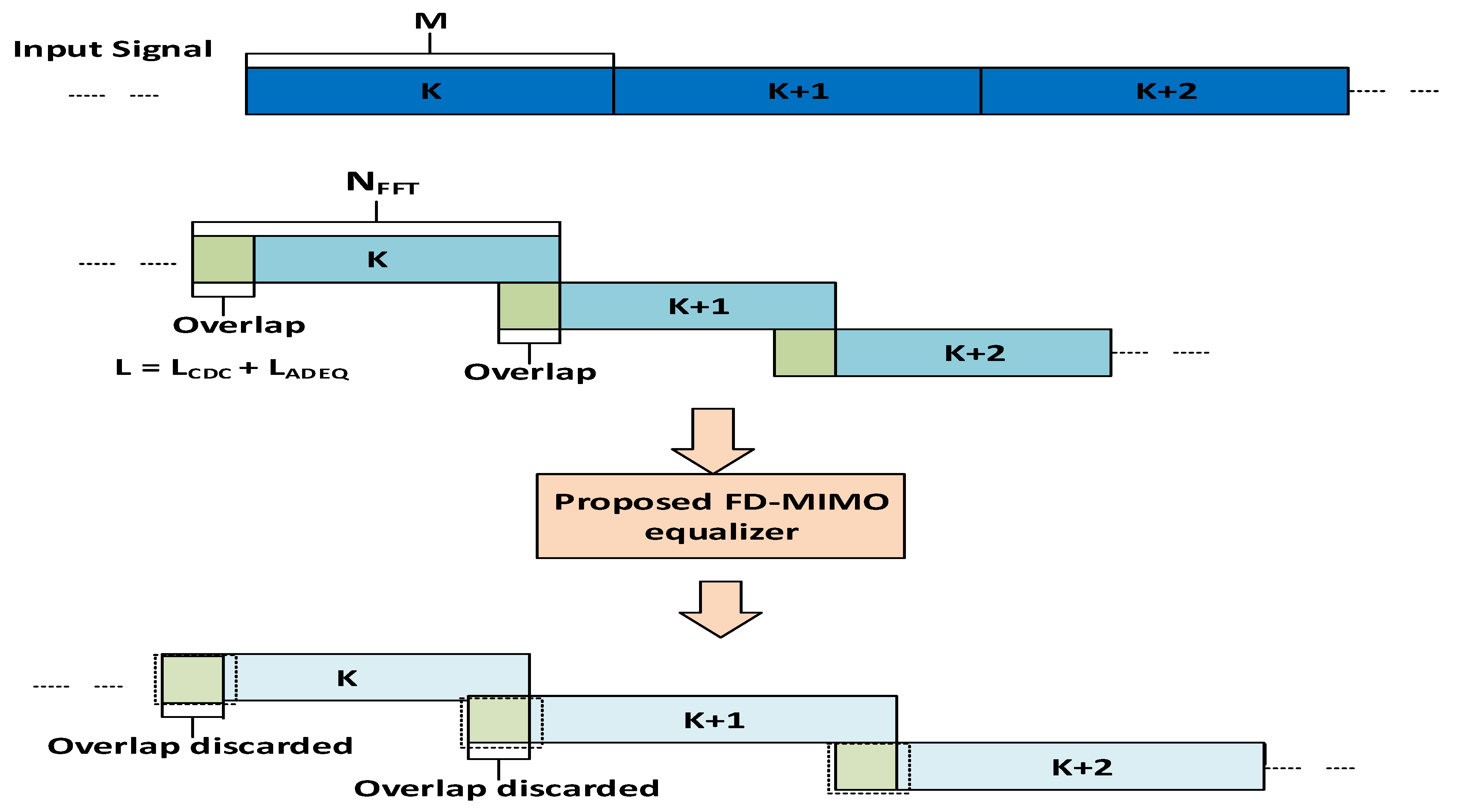
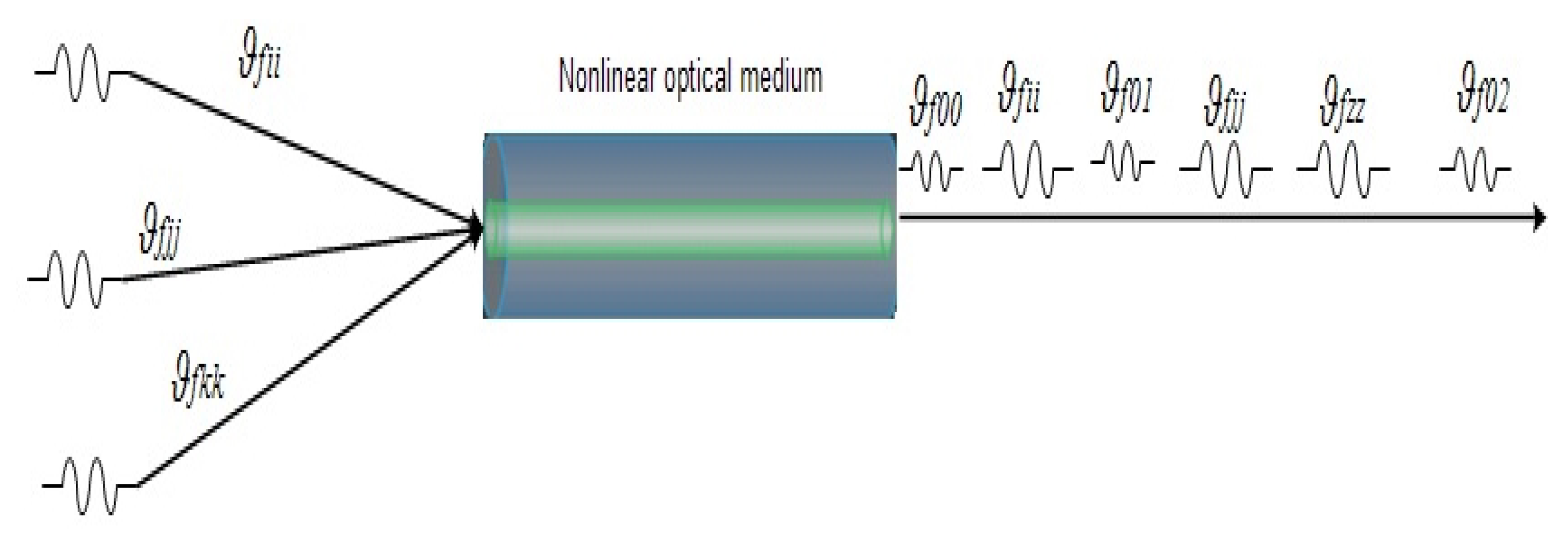



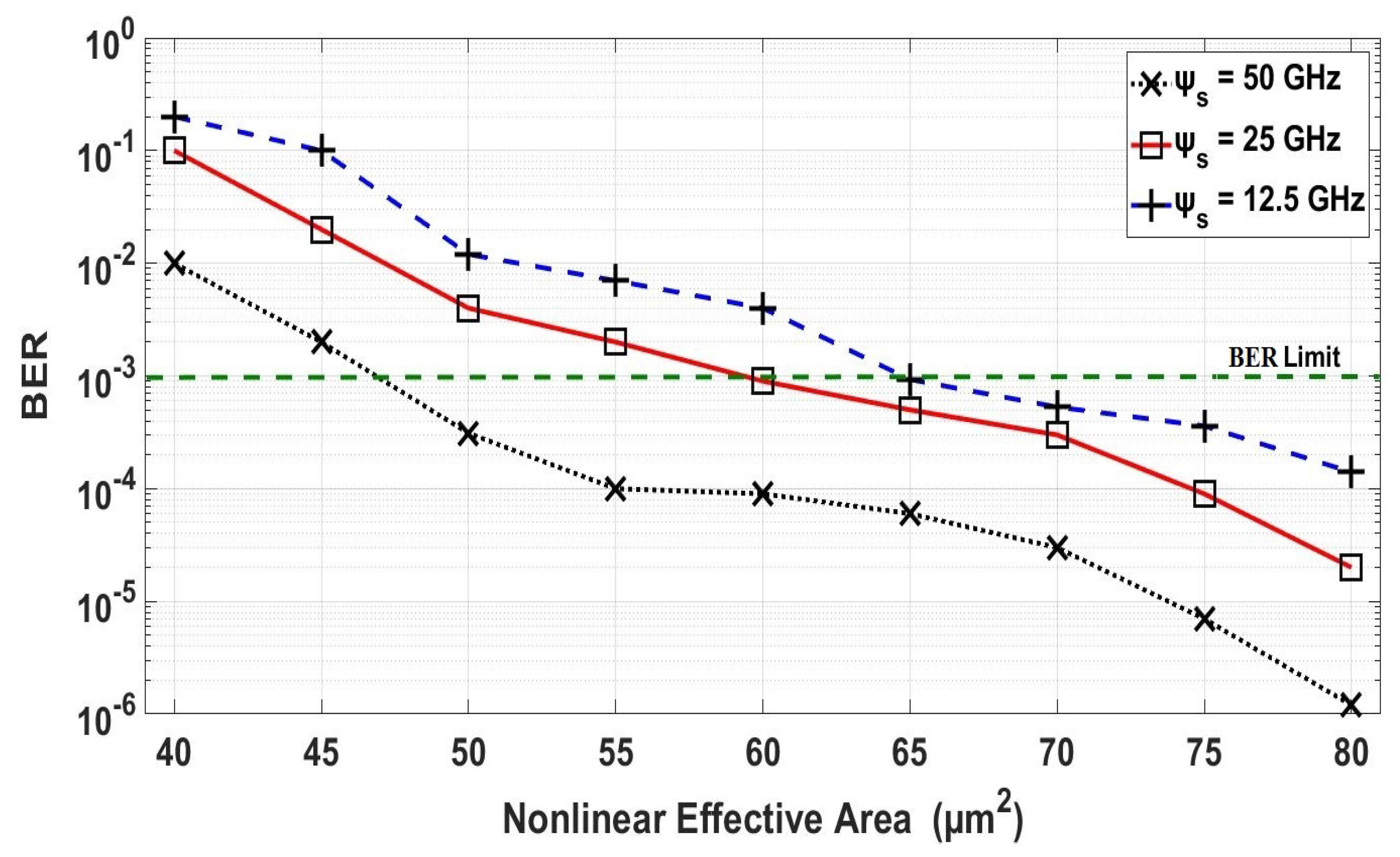
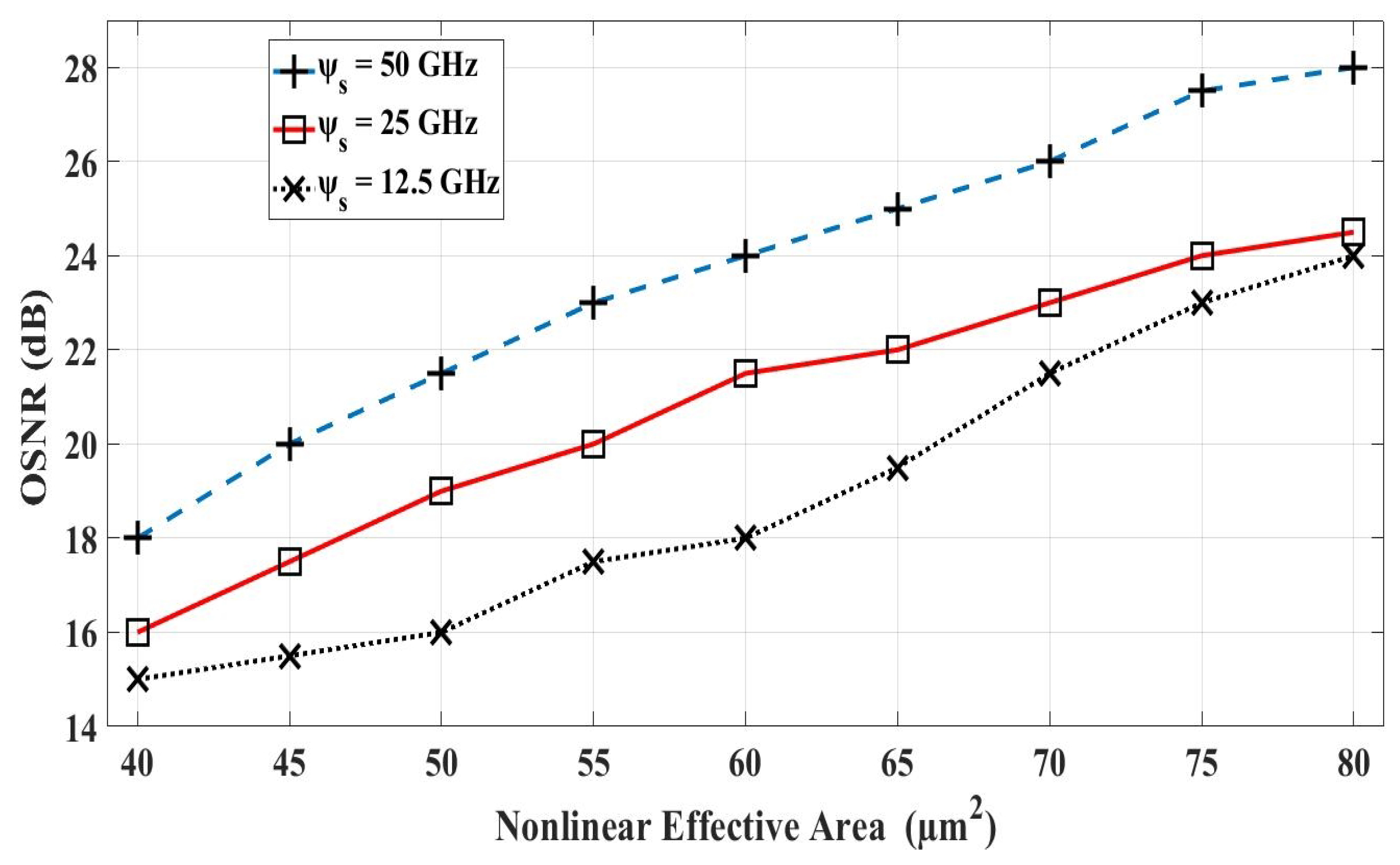

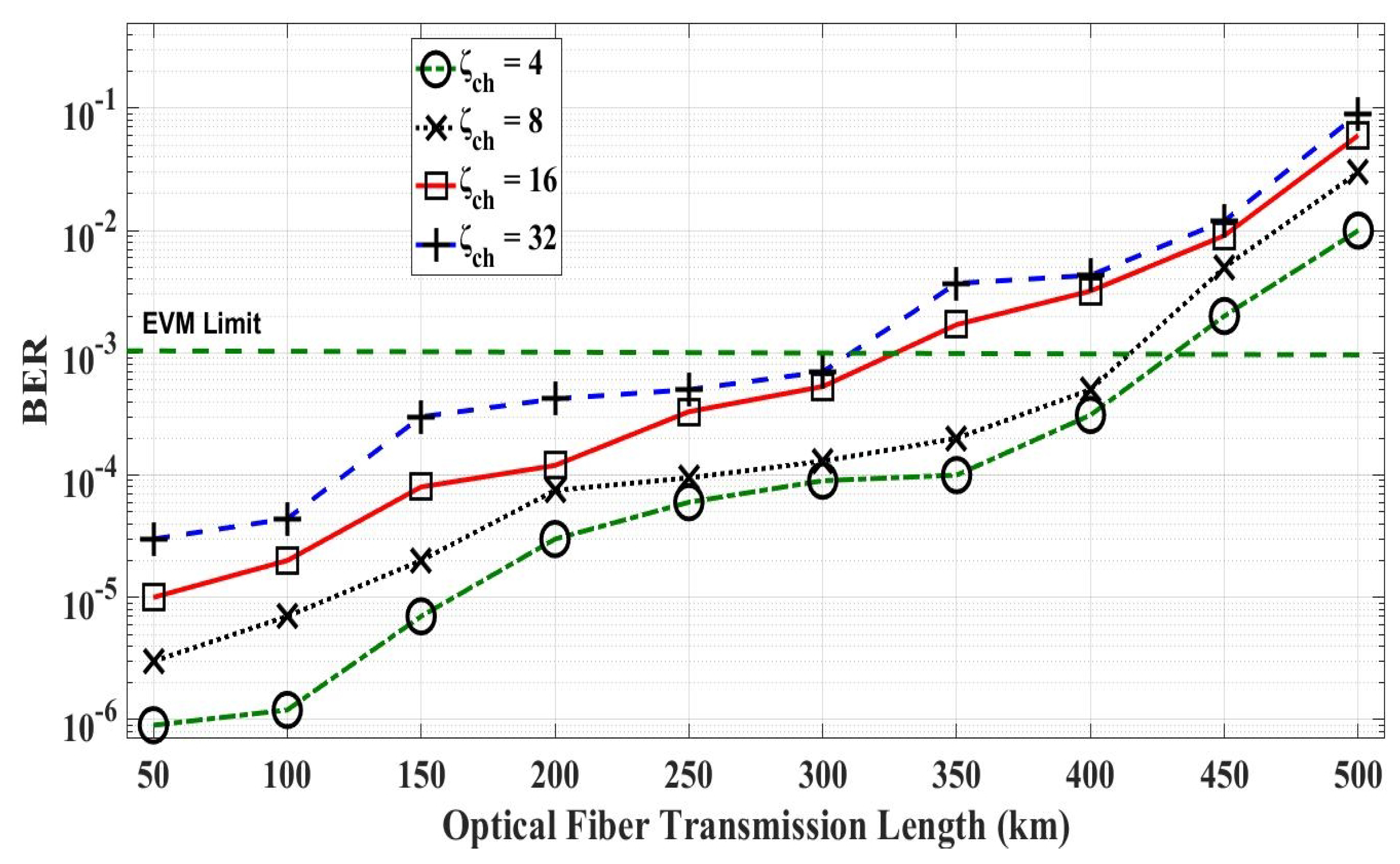
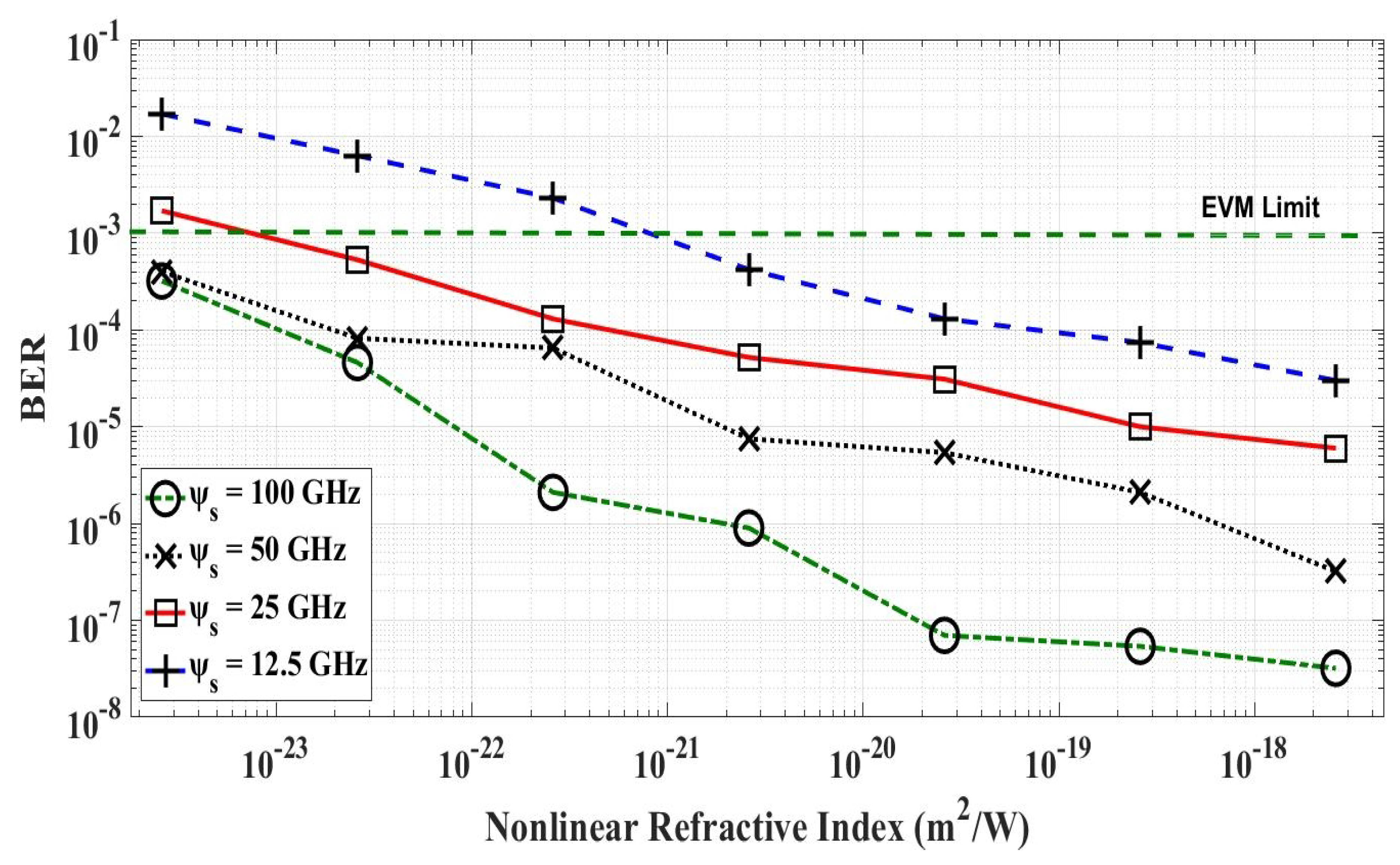
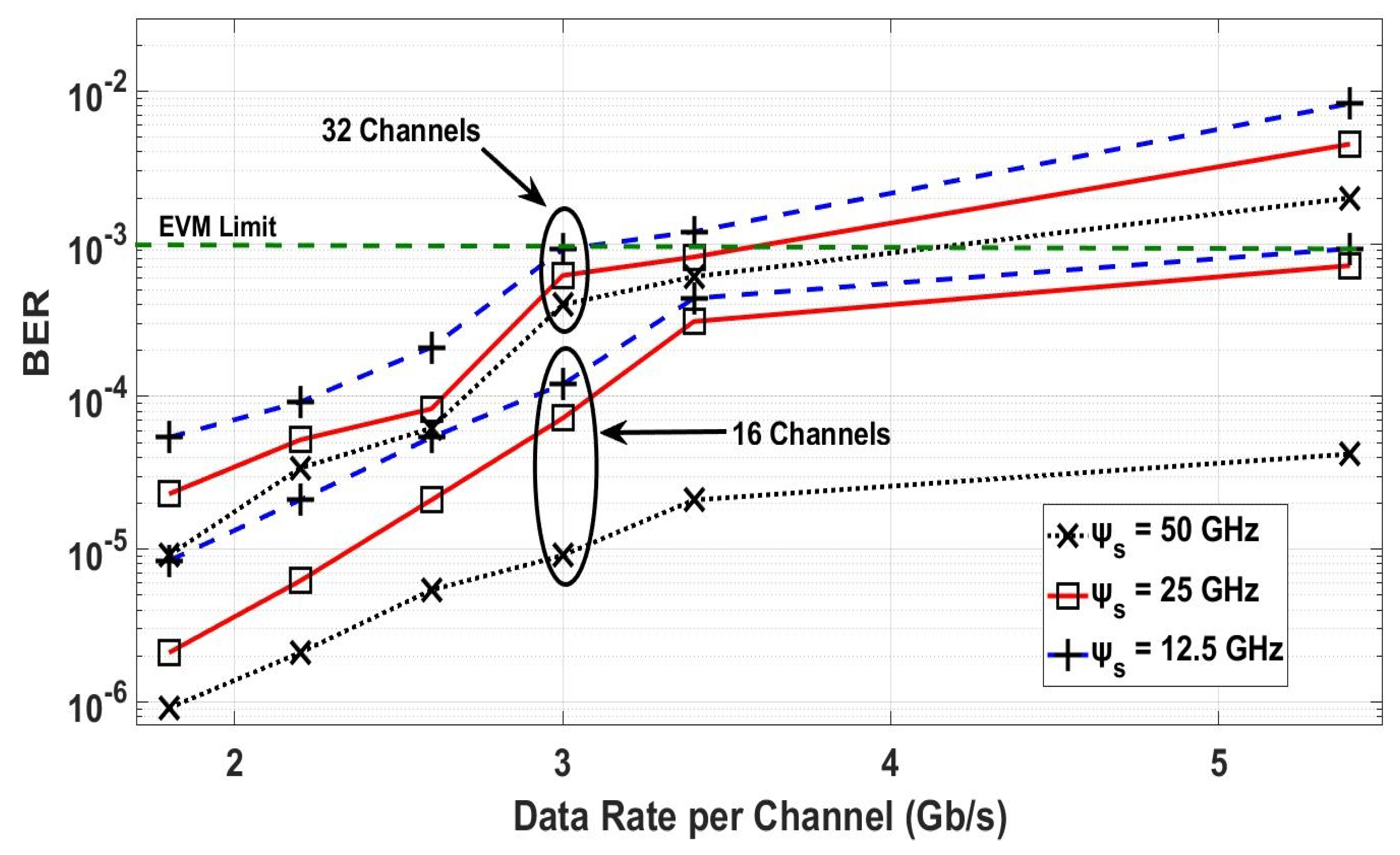
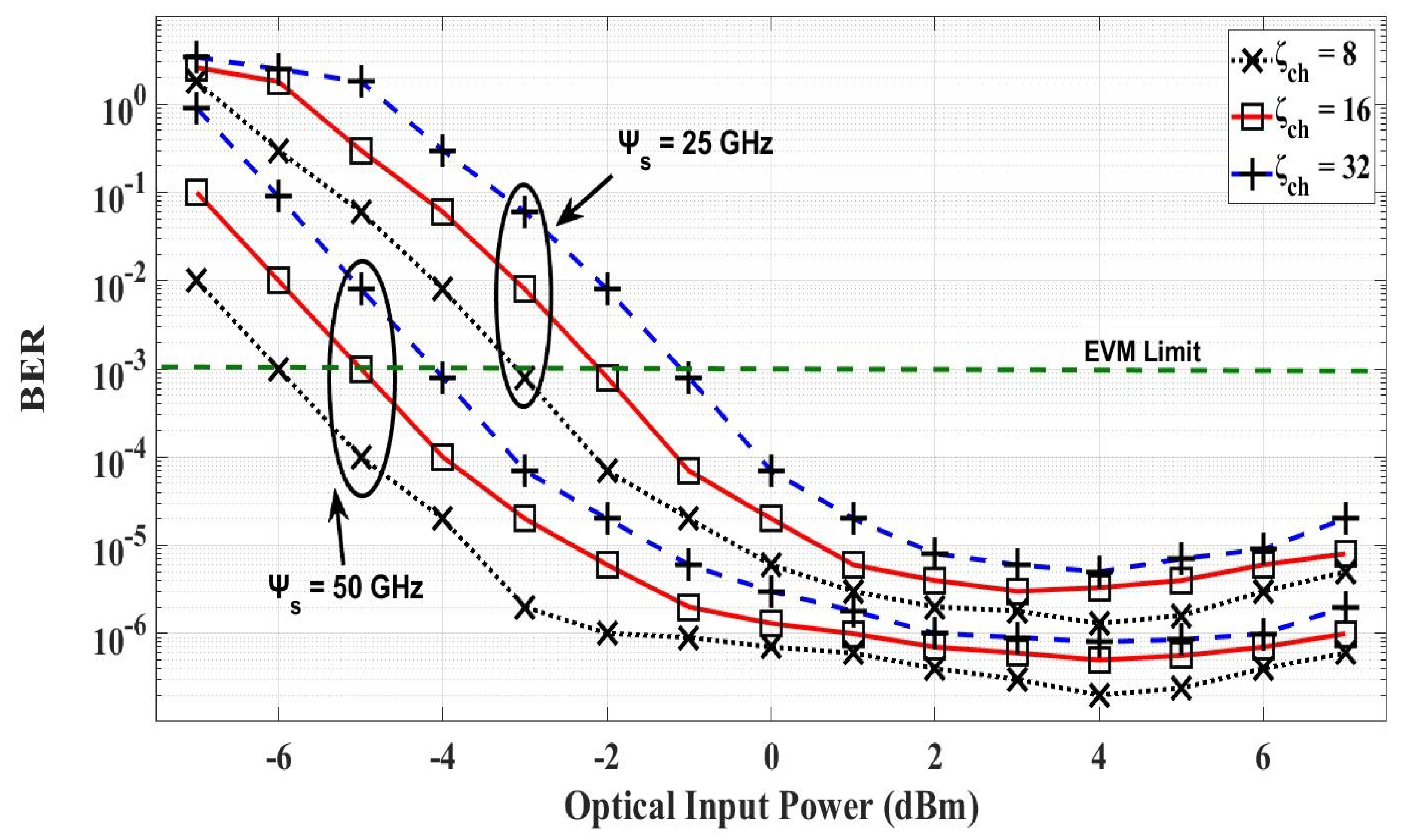
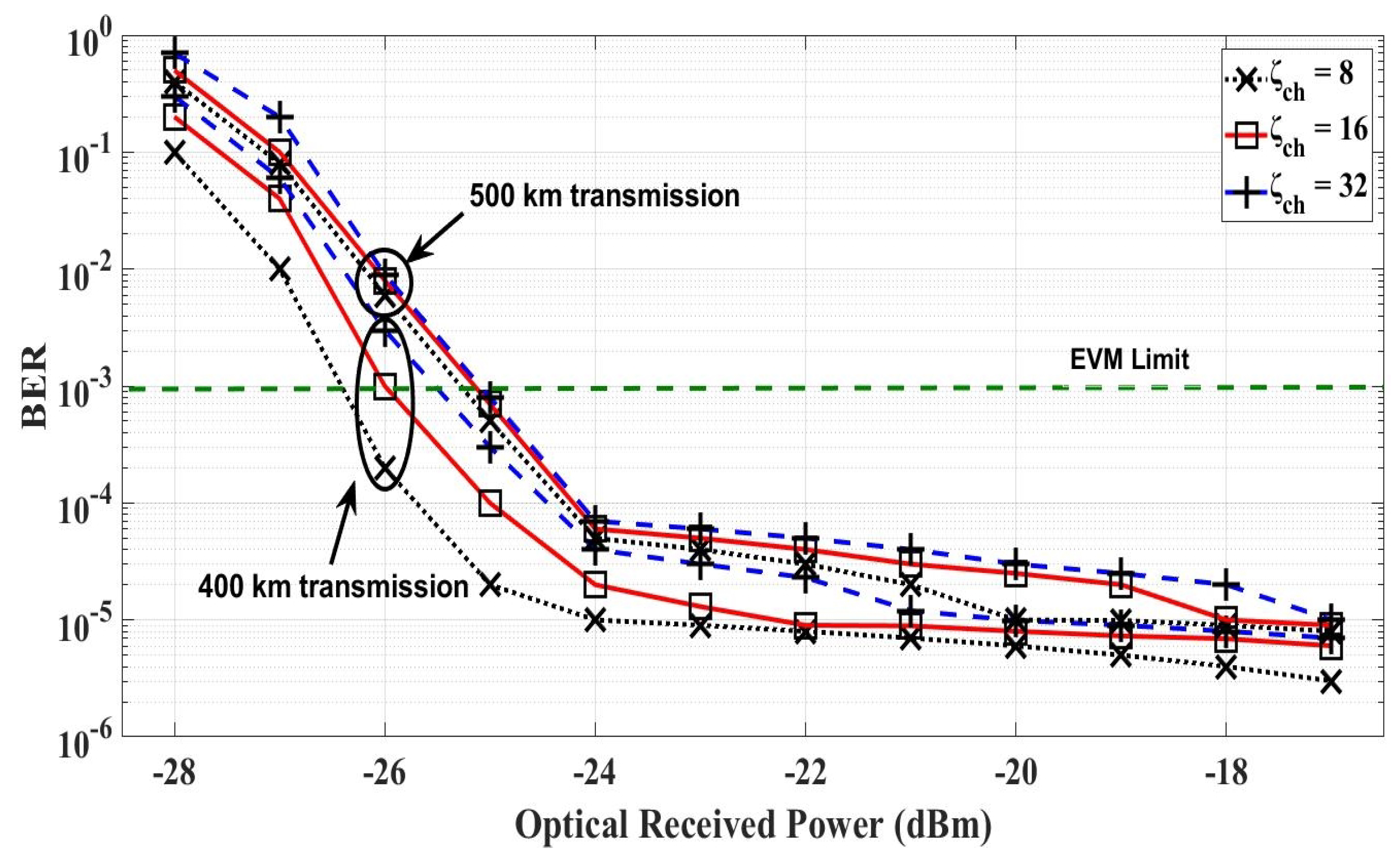
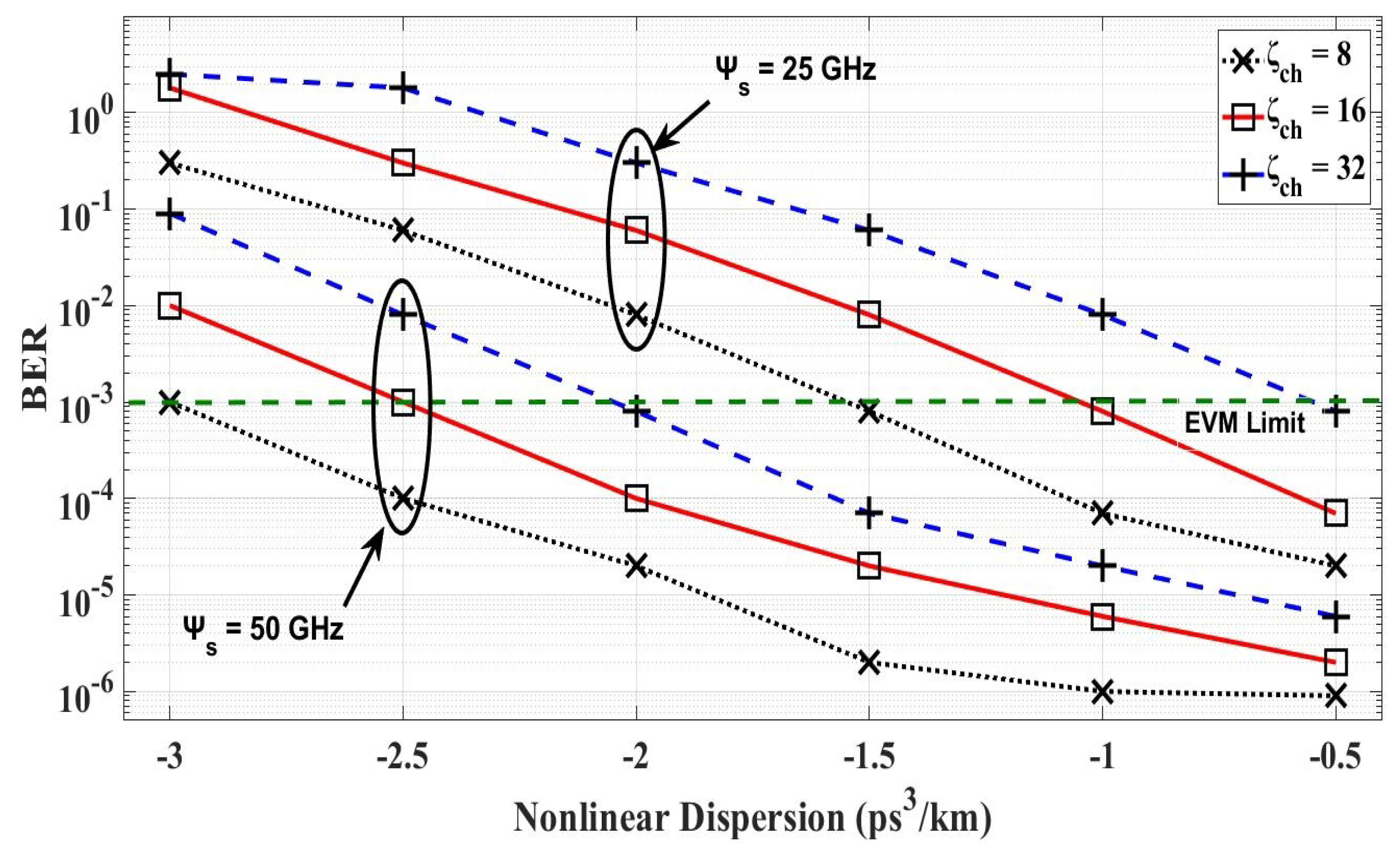
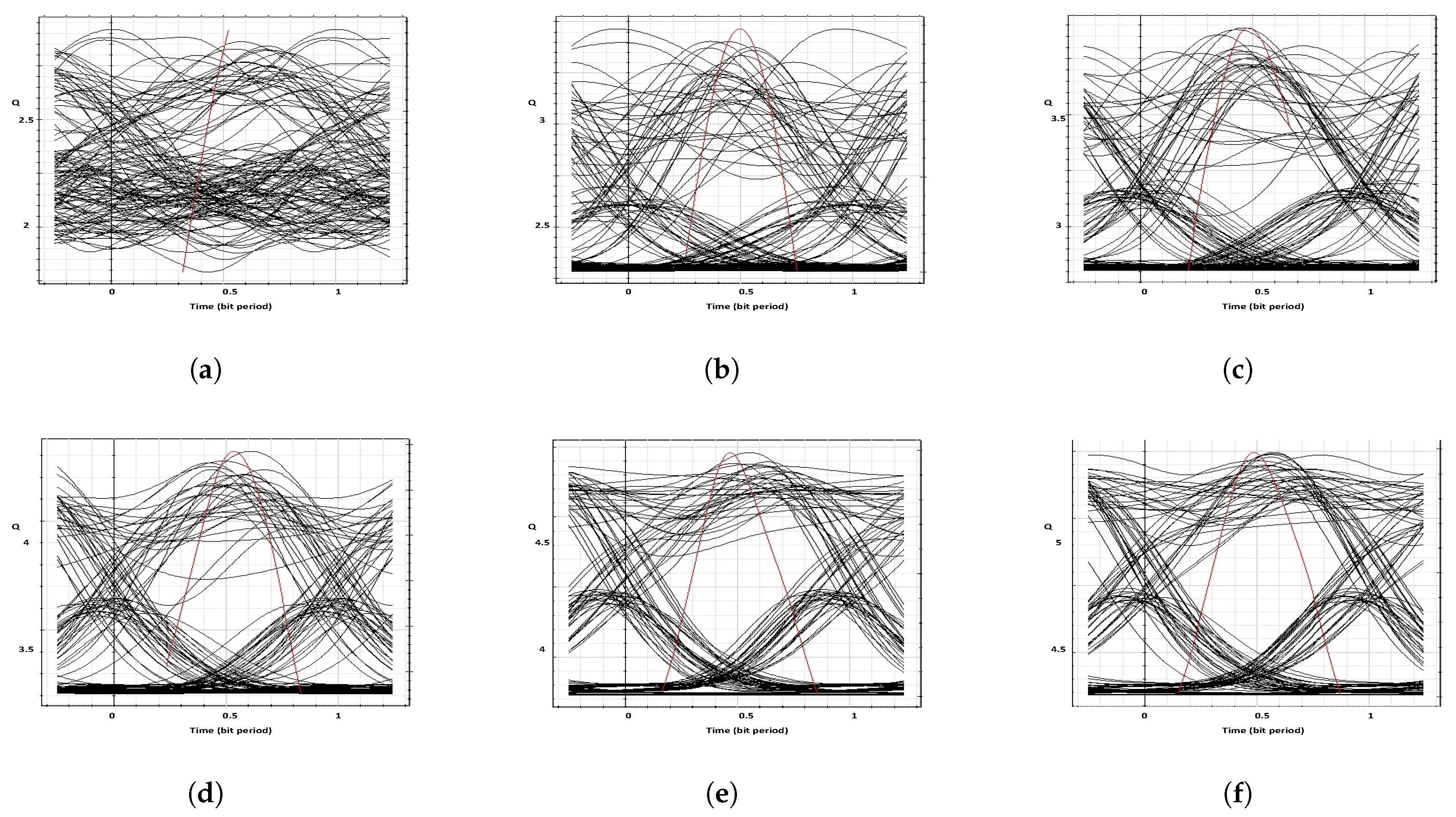
| Description | Magnitude |
|---|---|
| Reference wavelength | 1550 nm |
| Attenuation | 0.2 dB/km |
| Input power | −6 dBm to 6 dBm |
| Received power | −27 dBm to −16 dBm |
| Channel spacing | 50 GHz to 200 GHz |
| Length of fiber | 500 km |
| Nonlinear effective area | 80 m |
| Number of Channel | 4–32 |
| Nonlinear dispersion | −3 ps/km |
Publisher’s Note: MDPI stays neutral with regard to jurisdictional claims in published maps and institutional affiliations. |
© 2021 by the authors. Licensee MDPI, Basel, Switzerland. This article is an open access article distributed under the terms and conditions of the Creative Commons Attribution (CC BY) license (http://creativecommons.org/licenses/by/4.0/).
Share and Cite
Irfan, M.; Ali, F.; Muhammad, F.; Alwadie, A.S.; Glowacz, A.; Goldasz, I.; Mielnik, R.; Alkahtani, F.S.; Khan, H. An Optimal Framework for WDM Systems Using Analytical Characterization of Refractive Index-Related Nonlinear Impairments. Electronics 2021, 10, 221. https://doi.org/10.3390/electronics10030221
Irfan M, Ali F, Muhammad F, Alwadie AS, Glowacz A, Goldasz I, Mielnik R, Alkahtani FS, Khan H. An Optimal Framework for WDM Systems Using Analytical Characterization of Refractive Index-Related Nonlinear Impairments. Electronics. 2021; 10(3):221. https://doi.org/10.3390/electronics10030221
Chicago/Turabian StyleIrfan, Muhammad, Farman Ali, Fazal Muhammad, Abdullah S. Alwadie, Adam Glowacz, Iwona Goldasz, Ryszard Mielnik, Fahad Salem Alkahtani, and Hidayatullah Khan. 2021. "An Optimal Framework for WDM Systems Using Analytical Characterization of Refractive Index-Related Nonlinear Impairments" Electronics 10, no. 3: 221. https://doi.org/10.3390/electronics10030221
APA StyleIrfan, M., Ali, F., Muhammad, F., Alwadie, A. S., Glowacz, A., Goldasz, I., Mielnik, R., Alkahtani, F. S., & Khan, H. (2021). An Optimal Framework for WDM Systems Using Analytical Characterization of Refractive Index-Related Nonlinear Impairments. Electronics, 10(3), 221. https://doi.org/10.3390/electronics10030221





